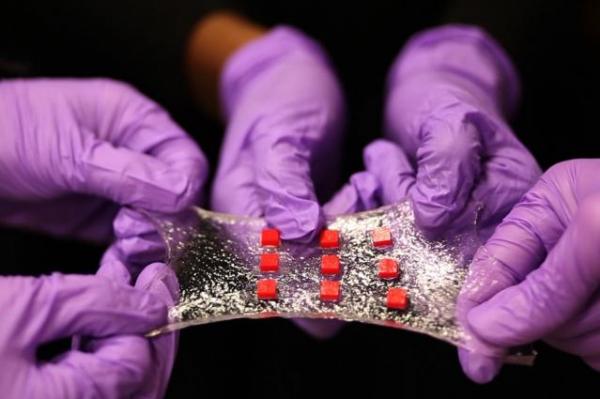
CAMBRIDGE, Mass., Dec. 8 (UPI) — In early November, scientists at the Massachusetts Institute of Technology showed off a new hydrogel that is stretchable and can stick to surfaces with strength that was compared to tendon or cartilage connecting to bone.
The same research team has now used the hydrogel to develop a “smart wound dressing” that stretches with the movements of the body, keeping electronics intact that monitor temperature and can deliver medication to patients either automatically or on demand.
Researchers at several institutions have developed versions of hydrogel, a water-based substance that varies based on other chemicals used for its development.
The MIT version increased the strength and stickiness of previous versions. Researchers said their hydrogel adheres to surfaces stronger than the natural adhesives used by mussels and barnacles to attach to cliff faces and ship hulls.
In addition to the surface of the skin, scientists said the development may allow electronics to be safely used inside the body and may eventually allow for neural devices or other uses in the brain because of similarities between the hydrogel and brain tissue.
“Electronics are usually hard and dry, but the human body is soft and wet,” said Xuanhe Zhao, an associate professor at MIT’s Department of Mechanical Engineering, in a press release. “These two systems have drastically different properties. If you want to put electronics in close contact with the human body for applications such as health care monitoring and drug delivery, it is highly desirable to make the electronic devices soft and stretchable to fit the environment of the human body. That’s the motivation for stretchable hydrogel electronics.”
In the new study published in Advanced Materials, MIT scientists show how they began exploring the potential of the new hydrogel by encapsulating a titanium wire in it to test its ability to conduct electricity, which maintained conductivity even while being stretched repeatedly.
An array of LED lights also was embedded in hyrdogel and, when attached to the body, including while being stretched and deformed around areas like the knee and elbow, the lights continued to work.
Combining the concepts, the scientists put electronic components into a sheet of hydrogel to create a wound dressing with regularly spaced temperature sensors and drug reservoirs, and pathways that allow medications to flow through the dressing. When the dressing was placed on skin, it successfully monitored temperature and released drugs based on its readings.
In addition to uses for burn patients or other skin conditions, Zhao said the hydrogel could eventually allow for electronics to be used inside the body to monitor glucose, or potentially could be used as neural probes. He said encasing something like a glucose probe in hydrogel may prevent the immune response the electronics typically cause.
The same research team has now used the hydrogel to develop a “smart wound dressing” that stretches with the movements of the body, keeping electronics intact that monitor temperature and can deliver medication to patients either automatically or on demand.
Researchers at several institutions have developed versions of hydrogel, a water-based substance that varies based on other chemicals used for its development.
The MIT version increased the strength and stickiness of previous versions. Researchers said their hydrogel adheres to surfaces stronger than the natural adhesives used by mussels and barnacles to attach to cliff faces and ship hulls.
In addition to the surface of the skin, scientists said the development may allow electronics to be safely used inside the body and may eventually allow for neural devices or other uses in the brain because of similarities between the hydrogel and brain tissue.
“Electronics are usually hard and dry, but the human body is soft and wet,” said Xuanhe Zhao, an associate professor at MIT’s Department of Mechanical Engineering, in a press release.
“These two systems have drastically different properties. If you want to put electronics in close contact with the human body for applications such as health care monitoring and drug delivery, it is highly desirable to make the electronic devices soft and stretchable to fit the environment of the human body. That’s the motivation for stretchable hydrogel electronics.”
In the new study published in Advanced Materials, MIT scientists show how they began exploring the potential of the new hydrogel by encapsulating a titanium wire in it to test its ability to conduct electricity, which maintained conductivity even while being stretched repeatedly.
An array of LED lights also was embedded in hyrdogel and, when attached to the body, including while being stretched and deformed around areas like the knee and elbow, the lights continued to work.
Combining the concepts, the scientists put electronic components into a sheet of hydrogel to create a wound dressing with regularly spaced temperature sensors and drug reservoirs, and pathways that allow medications to flow through the dressing. When the dressing was placed on skin, it successfully monitored temperature and released drugs based on its readings.
In addition to uses for burn patients or other skin conditions, Zhao said the hydrogel could eventually allow for electronics to be used inside the body to monitor glucose, or potentially could be used as neural probes. He said encasing something like a glucose probe in hydrogel may prevent the immune response the electronics typically cause.





